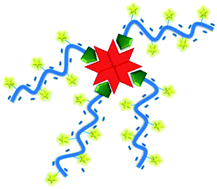Biotin-end-functionalized highly fluorescent water-soluble polymers†
Abstract
Many biosensing and imaging systems use

* Corresponding authors
a
École Normale Supérieure de Lyon, Laboratoire Joliot-Curie, CNRS USR 3010, F-69364 Lyon, France
E-mail:
marie-therese.charrreyre@ens-lyon.fr
b INSA-Lyon, Laboratoire Ingénierie des Matériaux Polymères, CNRS UMR 5223, F-69621 Villeurbanne, France
c
Centro de Química-Física Molecular and IN-Institute of Nanoscience and Nanotechnology, Instituto Superior Técnico, 1049-001 Lisbon, Portugal
E-mail:
farinha@ist.utl.pt
d Université de Lyon, Univ. Lyon 1, CPE Lyon, CNRS UMR 5265, Laboratoire de Chimie Catalyse Polymères et Procédés (C2P2), LCPP team, 43 Bd du 11 novembre 1918, F-69616 Villeurbanne, France
e Unité Mixte CNRS-bioMérieux, ENS de Lyon, F-69364 Lyon, France
Many biosensing and imaging systems use

 Please wait while we load your content...
Something went wrong. Try again?
Please wait while we load your content...
Something went wrong. Try again?
P. Relogio, M. Bathfield, Z. Haftek-Terreau, M. Beija, A. Favier, M. Giraud-Panis, F. D'Agosto, B. Mandrand, J. P. S. Farinha, M. Charreyre and J. M. G. Martinho, Polym. Chem., 2013, 4, 2968 DOI: 10.1039/C3PY00059A
To request permission to reproduce material from this article, please go to the Copyright Clearance Center request page.
If you are an author contributing to an RSC publication, you do not need to request permission provided correct acknowledgement is given.
If you are the author of this article, you do not need to request permission to reproduce figures and diagrams provided correct acknowledgement is given. If you want to reproduce the whole article in a third-party publication (excluding your thesis/dissertation for which permission is not required) please go to the Copyright Clearance Center request page.
Read more about how to correctly acknowledge RSC content.
 Fetching data from CrossRef.
Fetching data from CrossRef.
This may take some time to load.
Loading related content
